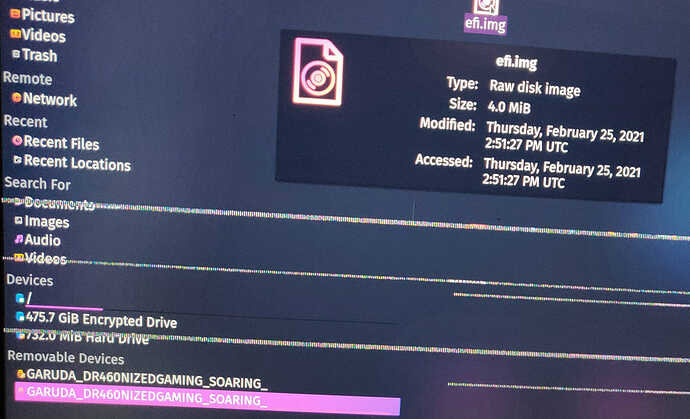Hi,
I'm currently using Linux Mint but I would like to try Garuda (I've been using Debian based distros for more than 10 years, maybe it's time to move on...)
Using Mint the video card works very well with both the video cards (nVidia and Intel), I can also play some 3d games on Steam without any problem
Can you help me to solve the problem?
Thank you very much for your time
PS
~$ inxi -Fxxxza
System: Kernel: 5.4.0-72-generic x86_64 bits: 64 compiler: gcc v: 9.3.0
parameters: BOOT_IMAGE=/vmlinuz-5.4.0-72-generic root=/dev/mapper/vgmint-root ro quiet splash
Desktop: Cinnamon 4.8.6 wm: muffin 4.8.1 dm: LightDM 1.30.0 Distro: Linux Mint 20.1 Ulyssa
base: Ubuntu 20.04 focal
Machine: Type: Laptop System: HUAWEI product: MACH-WX9 v: M19 serial: <filter>
Mobo: HUAWEI model: MACH-WX9-PCB v: M19 serial: <filter> UEFI: HUAWEI v: 1.28 date: 03/15/2019
Battery: ID-1: BAT0 charge: 55.8 Wh condition: 56.4/56.3 Wh (100%) volts: 8.6/7.6 model: DYNAPACK HB4593R1ECW
type: Li-ion serial: <filter> status: Unknown cycles: 23
CPU: Topology: Quad Core model: Intel Core i7-8550U bits: 64 type: MT MCP arch: Kaby Lake family: 6
model-id: 8E (142) stepping: A (10) microcode: E0 L2 cache: 8192 KiB
flags: avx avx2 lm nx pae sse sse2 sse3 sse4_1 sse4_2 ssse3 vmx bogomips: 31999
Speed: 800 MHz min/max: 400/4000 MHz Core speeds (MHz): 1: 800 2: 800 3: 800 4: 801 5: 800 6: 800
7: 800 8: 800
Vulnerabilities: Type: itlb_multihit status: KVM: Split huge pages
Type: l1tf mitigation: PTE Inversion; VMX: conditional cache flushes, SMT vulnerable
Type: mds mitigation: Clear CPU buffers; SMT vulnerable
Type: meltdown mitigation: PTI
Type: spec_store_bypass mitigation: Speculative Store Bypass disabled via prctl and seccomp
Type: spectre_v1 mitigation: usercopy/swapgs barriers and __user pointer sanitization
Type: spectre_v2
mitigation: Full generic retpoline, IBPB: conditional, IBRS_FW, STIBP: conditional, RSB filling
Type: srbds mitigation: Microcode
Type: tsx_async_abort status: Not affected
Graphics: Device-1: Intel UHD Graphics 620 vendor: Huawei driver: i915 v: kernel bus ID: 00:02.0
chip ID: 8086:5917
Device-2: NVIDIA GP108M [GeForce MX150] vendor: Huawei driver: nvidia v: 460.56 bus ID: 01:00.0
chip ID: 10de:1d12
Display: x11 server: X.Org 1.20.9 driver: modesetting,nvidia unloaded: fbdev,nouveau,vesa
resolution: 3000x2000~60Hz
OpenGL: renderer: Mesa Intel UHD Graphics 620 (KBL GT2) v: 4.6 Mesa 20.2.6 direct render: Yes
Audio: Device-1: Intel Sunrise Point-LP HD Audio vendor: Huawei driver: snd_hda_intel v: kernel
bus ID: 00:1f.3 chip ID: 8086:9d71
Sound Server: ALSA v: k5.4.0-72-generic
Network: Device-1: Intel Wireless 8265 / 8275 vendor: Huawei driver: iwlwifi v: kernel port: 3000
bus ID: 3c:00.0 chip ID: 8086:24fd
IF: wlp60s0 state: up mac: <filter>
IF-ID-1: virbr0 state: down mac: <filter>
IF-ID-2: virbr0-nic state: down mac: <filter>
Drives: Local Storage: total: 476.94 GiB used: 61.41 GiB (12.9%)
SMART Message: Required tool smartctl not installed. Check --recommends
ID-1: /dev/nvme0n1 vendor: Samsung model: MZVLB512HAJQ-00000 size: 476.94 GiB block size:
physical: 512 B logical: 512 B speed: 31.6 Gb/s lanes: 4 serial: <filter> rev: EXA7301Q scheme: GPT
Partition: ID-1: / raw size: 474.75 GiB size: 466.30 GiB (98.22%) used: 61.00 GiB (13.1%) fs: ext4
dev: /dev/dm-1
ID-2: /boot raw size: 732.0 MiB size: 704.5 MiB (96.24%) used: 403.4 MiB (57.3%) fs: ext4
dev: /dev/nvme0n1p2
ID-3: swap-1 size: 980.0 MiB used: 0 KiB (0.0%) fs: swap swappiness: 60 (default)
cache pressure: 100 (default) dev: /dev/dm-2
Sensors: System Temperatures: cpu: 50.5 C mobo: N/A
Fan Speeds (RPM): N/A
Info: Processes: 297 Uptime: 7m Memory: 7.53 GiB used: 1.91 GiB (25.4%) Init: systemd v: 245 runlevel: 5
Compilers: gcc: 9.3.0 alt: 9 Shell: bash v: 5.0.17 running in: gnome-terminal inxi: 3.0.38
SGS
16 April 2021 20:47
2
Hi
No internet-connection, please post full ISO name you use.
Post
inxi -Fxxxza
from live ISO, save on second USB if possible
If you include terminal outputs in your post please use the proper output format in your post. Using “~” 3 times above and “~” 3 times below the text block will provide a readable, raw look.
Read
Writing a well formatted post in the forum (Discource powered) is important, if you want readers to easily read and understand.
It's especially important for terminal output.
Here is a brief tutorial.
please
and
2 Likes
Hi,
The ISO I am using is named garuda-dr460nized-gaming-linux-zen-210406.iso (sha256=708722ecfcaf4ee995693b241fec6f674cf85139b0eb1136736482261148489c)
From the command line on my Garuda Live USB key I have:
╭─garuda@garuda in ~
╰─λ uname -a
Linux garuda-dr460nized-gaming 5.11.1-zen1-1-zen #1 ZEN SMP PREEMPT Tue, 23 Feb 2021 14:05:33 +0000 x86_64 GNU/Linux
╭─garuda@garuda in ~
╰─λ inxi -Fxxxza
System: Kernel: 5.11.1-zen1-1-zen x86_64 bits: 64 compiler: gcc v: 10.2.1
parameters: BOOT_IMAGE=/boot/vmlinuz-x86_64 lang=en_US keytable=us tz=UTC misobasedir=garuda
misolabel=GARUDA_DR460NIZEDGAMING_SOARING_ quiet systemd.show_status=1 splash
rd.udev.log_priority=3 vt.global_cursor_default=0 systemd.unified_cgroup_hierarchy=1
driver=nonfree nouveau.modeset=0 i915.modeset=1 radeon.modeset=1
Desktop: KDE Plasma 5.21.1 tk: Qt 5.15.2 info: latte-dock wm: kwin_x11 dm: SDDM
Distro: Garuda Linux
Machine: Type: Laptop System: HUAWEI product: MACH-WX9 v: M19 serial: <filter>
Mobo: HUAWEI model: MACH-WX9-PCB v: M19 serial: <filter> UEFI: HUAWEI v: 1.28 date: 03/15/2019
Battery: ID-1: BAT0 charge: 55.6 Wh condition: 56.3/56.3 Wh (100%) volts: 8.6/7.6
model: DYNAPACK HB4593R1ECW type: Li-ion serial: <filter> status: Unknown cycles: 23
CPU: Info: Quad Core model: Intel Core i7-8550U bits: 64 type: MT MCP arch: Kaby Lake note: check
family: 6 model-id: 8E (142) stepping: A (10) microcode: E0 L2 cache: 8 MiB
flags: avx avx2 lm nx pae sse sse2 sse3 sse4_1 sse4_2 ssse3 vmx bogomips: 31999
Speed: 2448 MHz min/max: 400/4000 MHz Core speeds (MHz): 1: 2448 2: 2537 3: 3220 4: 3123
5: 2697 6: 2797 7: 2412 8: 3570
Vulnerabilities: Type: itlb_multihit status: KVM: VMX disabled
Type: l1tf mitigation: PTE Inversion; VMX: conditional cache flushes, SMT vulnerable
Type: mds mitigation: Clear CPU buffers; SMT vulnerable
Type: meltdown mitigation: PTI
Type: spec_store_bypass mitigation: Speculative Store Bypass disabled via prctl and seccomp
Type: spectre_v1 mitigation: usercopy/swapgs barriers and __user pointer sanitization
Type: spectre_v2
mitigation: Full generic retpoline, IBPB: conditional, IBRS_FW, STIBP: conditional, RSB filling
Type: srbds mitigation: Microcode
Type: tsx_async_abort status: Not affected
Graphics: Device-1: Intel UHD Graphics 620 vendor: Huawei driver: i915 v: kernel bus ID: 00:02.0
chip ID: 8086:5917 class ID: 0300
Device-2: NVIDIA GP108M [GeForce MX150] vendor: Huawei driver: N/A alternate: nouveau
bus ID: 01:00.0 chip ID: 10de:1d12 class ID: 0302
Device-3: Cheng Uei Precision Industry (Foxlink) HD Camera type: USB driver: uvcvideo
bus ID: 1-7:5 chip ID: 05c8:03c0 class ID: 0e02
Display: x11 server: X.Org 1.20.10 compositor: kwin_x11 driver: loaded: intel
unloaded: modesetting alternate: fbdev,vesa display ID: :0 screens: 1
Screen-1: 0 s-res: 3000x2000 s-dpi: 96 s-size: 793x529mm (31.2x20.8") s-diag: 953mm (37.5")
Monitor-1: eDP1 res: 3000x2000 hz: 60 dpi: 263 size: 290x200mm (11.4x7.9") diag: 352mm (13.9")
OpenGL: renderer: Mesa Intel UHD Graphics 620 (KBL GT2) v: 4.6 Mesa 20.3.4 direct render: Yes
Audio: Device-1: Intel Sunrise Point-LP HD Audio vendor: Huawei driver: snd_hda_intel v: kernel
alternate: snd_soc_skl bus ID: 00:1f.3 chip ID: 8086:9d71 class ID: 0403
Sound Server: ALSA v: k5.11.1-zen1-1-zen
Network: Device-1: Intel Wireless 8265 / 8275 vendor: Huawei driver: iwlwifi v: kernel port: 3000
bus ID: 3c:00.0 chip ID: 8086:24fd class ID: 0280
IF: wlp60s0 state: down mac: <filter>
Bluetooth: Device-1: Intel Bluetooth wireless interface type: USB driver: btusb v: 0.8 bus ID: 1-5:3
chip ID: 8087:0a2b class ID: e001
Message: Required tool hciconfig not installed. Check --recommends
Drives: Local Storage: total: 520.51 GiB used: 1.15 GiB (0.2%)
SMART Message: Unable to run smartctl. Root privileges required.
ID-1: /dev/nvme0n1 maj-min: 259:0 vendor: Samsung model: MZVLB512HAJQ-00000 size: 476.94 GiB
block size: physical: 512 B logical: 512 B speed: 31.6 Gb/s lanes: 4 rotation: SSD
serial: <filter> rev: EXA7301Q temp: 32.9 C scheme: GPT
ID-2: /dev/sda maj-min: 8:0 type: USB vendor: SanDisk model: Ultra USB 3.0 size: 14.32 GiB
block size: physical: 512 B logical: 512 B serial: <filter> rev: 1.00 scheme: MBR
SMART Message: Unknown USB bridge. Flash drive/Unsupported enclosure?
ID-3: /dev/sdb maj-min: 8:16 type: USB vendor: SanDisk model: Cruzer Glide size: 29.25 GiB
block size: physical: 512 B logical: 512 B serial: <filter> rev: 1.00 scheme: MBR
SMART Message: Unknown USB bridge. Flash drive/Unsupported enclosure?
Partition: ID-1: / raw size: N/A size: 5.64 GiB used: 1.15 GiB (20.4%) fs: overlay source: ERR-102
Swap: Kernel: swappiness: 10 (default 60) cache pressure: 75 (default 100)
ID-1: swap-1 type: zram size: 962.9 MiB used: 0 KiB (0.0%) priority: 32767 dev: /dev/zram0
ID-2: swap-2 type: zram size: 962.9 MiB used: 0 KiB (0.0%) priority: 32767 dev: /dev/zram1
ID-3: swap-3 type: zram size: 962.9 MiB used: 0 KiB (0.0%) priority: 32767 dev: /dev/zram2
ID-4: swap-4 type: zram size: 962.9 MiB used: 0 KiB (0.0%) priority: 32767 dev: /dev/zram3
ID-5: swap-5 type: zram size: 962.9 MiB used: 0 KiB (0.0%) priority: 32767 dev: /dev/zram4
ID-6: swap-6 type: zram size: 962.9 MiB used: 0 KiB (0.0%) priority: 32767 dev: /dev/zram5
ID-7: swap-7 type: zram size: 962.9 MiB used: 0 KiB (0.0%) priority: 32767 dev: /dev/zram6
ID-8: swap-8 type: zram size: 962.9 MiB used: 0 KiB (0.0%) priority: 32767 dev: /dev/zram7
Sensors: System Temperatures: cpu: 46.5 C mobo: N/A
Fan Speeds (RPM): N/A
Info: Processes: 248 Uptime: 9m wakeups: 1 Memory: 7.52 GiB used: 3.87 GiB (51.5%) Init: systemd
v: 247 Compilers: gcc: 10.2.0 clang: 11.1.0 Packages: pacman: 1653 lib: 504 Shell: fish
v: 3.1.2 running in: konsole inxi: 3.3.01
thank you for your help
Maybe.
3 Likes
I have the same issue whether on the boot screen I select the proprietary drivers or open source drivers.
And yet:
Can you explain why your up-to-date installer image has a two-month-old kernel version?
3 Likes
jonathon, I think you're right!
This is not the first time I try to run Garuda.
I tried again some time later, I downloaded a new version and put it on a USB key. It didn't start...
After a few search on the web I read that a guy had a similar problem and the solution was just to use a different USB key (it seems that the UEFI software on his PC was not able to boot SOME USB keys).
How can I find out what ISO version is on the USB key?
Thank you,
SGS
18 April 2021 17:59
8
Just look in file browser.
Sample.
The ISO image I am using, on the file browser, looks like this.
SGS
18 April 2021 21:20
10
Thats an old ISO, maybe developer test, usehttps://builds.garudalinux.org/iso/garuda/dr460nized-gaming/210406/
1 Like
Barebones use standard linux kernel. You may also try them.
1 Like
I tried a lot of different Linux distros both arch based and debian based (Manjaro, RebornOS, PopOs, Ubuntu 21.04...) using a recent Linux Kernel (version >= 5.9) and, at the moment, on my PC, all of them (except for one) have the same very problem shown in the previous picture.
thank you very much
4 Likes




